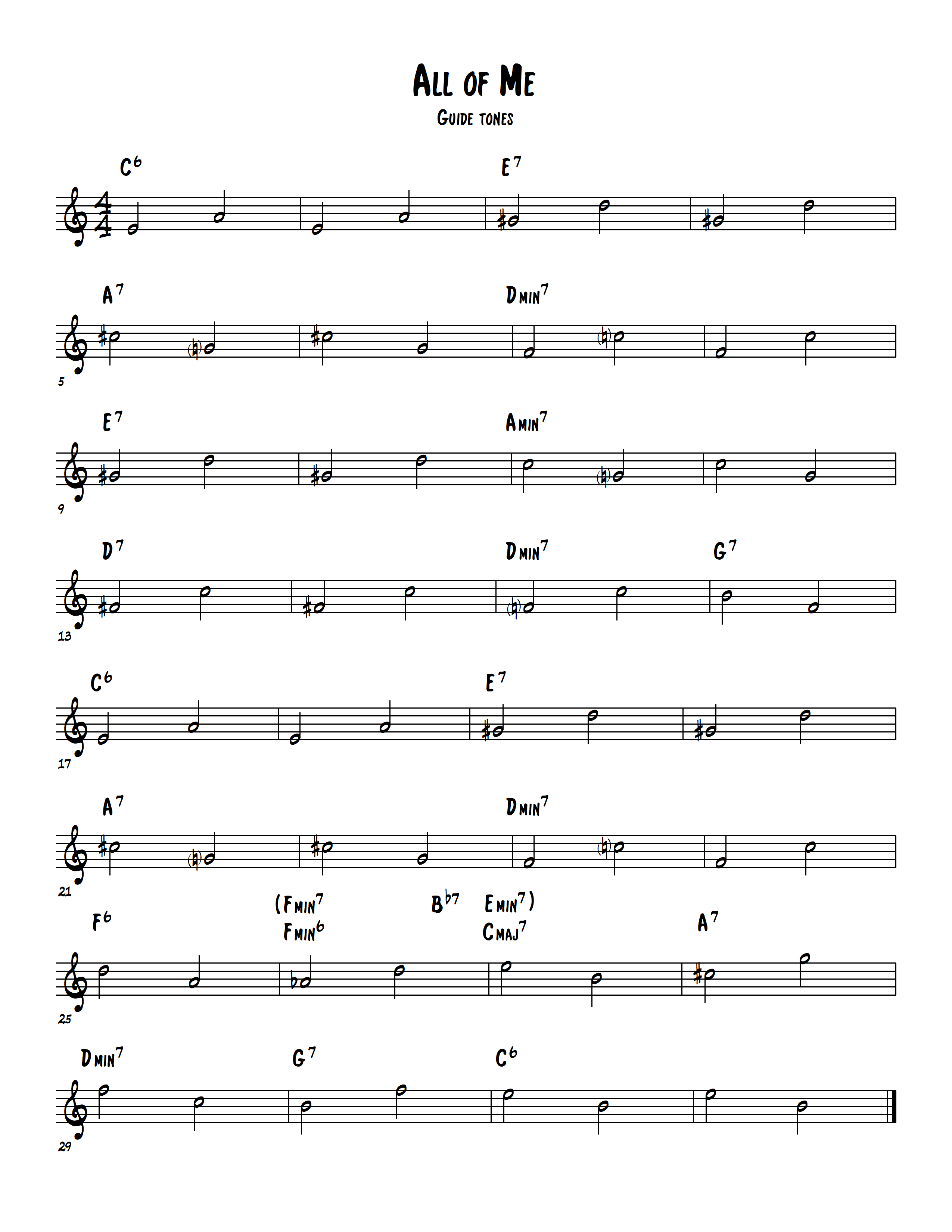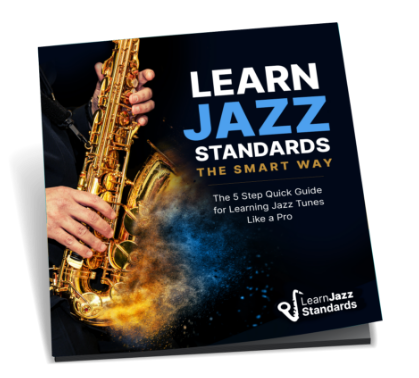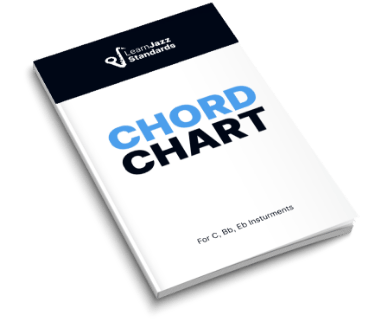Welcome to episode 106 of the LJS Podcast where today we are moving forward in Jazz Standards Month to talk about mapping out a tune you are learning. We’ll explore mapping out the guide tones and chord tones to build a strong foundation for your improvisation. Listen in!
Listen to episode 106
In today’s episode, we are continuing on through Jazz Standards Month. This time around I discuss how to “map out” a jazz standard you are learning so that you can get started on the right foot.
I think it’s important, no matter what level you are at, to go back to the basics. How do you spell out a chord, what are the defining notes in that chord, and ultimately, how can you use that information to inform your improvisation?
I talk about defining the guide tones (the 3rds and 7ths), how to voice lead them, and how to utilize chord tones effectively. I believe that if we go back to these foundational elements we can set ourselves up for success on the bandstand.
Here’s what I talk about today:
1. The basic elements of mapping.
2. Defining the different qualities of 7th chords.
3. Defining guide tones and how to voice lead them.
4. Guide tones over “All of Me.”
5. A helpful exercise for practicing chord tones over “All of Me.”
Here are some of the musical examples I refer to in this episode:
Guide tones over a ii-V-I
All of Me Guide Tones
All of Me Chord Tone Exercise
Important Links
The Jazz Standards Playbook[vc_separator]
Free Guide to learn standards by ear: Learn Jazz Standards the Smart Way
Read the Transcript
Brent: All right. What’s up everybody? My name is Brent. I am the jazz musician behind the website LearnJazzStandards.com, which is a blog and a podcast and videos, all geared towards helping you become a better jazz musician. Welcome, everybody. Thanks for listening. Thanks for hanging out today, and wow, I just to say first of all, a big thank you to everybody who participated in our podcast raffle back in February. Man, that was super-awesome, and we just got a lot of reviews on iTunes, I got a lot of suggestions from you from future episodes. So I just want to thank everybody publicly first, just for participating in that and just helping out. I really appreciate it, and I just sent out emails to 17 lucky winners of our raffle.
I’m not going to name all of you, because you know who you are, I’ve sent you an email, but I want to publicly thank our number one winner, who won both of our jazz courses, our ear training course, “How To Play What You Hear”, and our practicing course, “30 Days to Better Jazz Playing”, as well as our entire library of jazz standard play-alongs, Megan Campbell from Seattle, Washington. So thank you so much, Megan, and congratulations. I really appreciate you being a listener, and I appreciate everybody who participated in our competition.
Now, last week on the podcast we started jazz standards month. Sometimes we do themes on this podcast where we hone in on one specific topic for an entire month and just really try to get inside of that topic. So for the month of March we are doing jazz standards month. I’m excited about this, and last week we talked about analyzing jazz standards with Roman numerals, and how by doing this we can really unlock the song that we’re learning. We can understand it better, we can understand the harmony, and it’s going to set us up for success in the long run when it comes to playing and performing this particular tune.
Today we’re going to talk about step number two, which is all about mapping out the song. We’re going to be discovering what chord tones we can use in that song and what are the important notes that we need to hone in on to really get those chord changes to come out. And by doing this, we’re going to be setting ourself up for success when we go to improvise over this particular jazz standard. So I’m really excited about this.
And also, along with jazz standards month, I’m excited because in April we’re going to be launching our brand new ebook and companion course, “The Jazz Standards Playbook”. I’m really excited about this book, because it goes through 10 jazz standards studies of jazz standards that are important to know, but more than that, it’s important to dig into them and look into their improvisational stories and their lessons that they can teach us, because it’s going to help us in the long run just being able to play jazz so much better, no matter what song it is. So I’m really excited about that book. If you want to be the first one to get notified when that comes out, go to TheJazzStandardsPlaybook.com, and you’ll be on our list.
All right, without further ado, let’s jump into today’s show.
All right, you can find the show notes for today’s show at LearnJazzStandards.com/episode106. Now, you don’t need to look at the show notes for today’s episode to get lots of value out of it, and by the way, that’s my goal every single week, is just to offer you as much value as I possibly can, so you have something to walk away and take into action. But you don’t need the show notes today. It could be helpful for you, because I will have some musical examples, but you will get just as much out of it just by listening, so no worries if you can’t access those show notes right now.
We’re talking about mapping out a jazz standard today, and for today we’re going to use an example, the jazz standard, “All of Me”, which I think everybody knows that song, “All of Me”. If you don’t know it, that’s okay, look it up. It’s a Gerald Marks tune, and it’s really important to know. Now, when we’re talking about mapping out a song of any kind, in this case a jazz standard, I’m talking about looking into the different chord tones that we can explore and use in our improvisation. Now, in “The Jazz Standards Playbook”, I talk about a couple of different kinds of mapping, but we’re just going to focus on the very basic, the fundamental building blocks of mapping out the jazz standard. And like I said in the intro, last week we talked about analyzing a song by Roman numerals, but now we’re going to dig a little bit deeper, because we want to know what those chords actually mean in and of themselves.
The best place to start, and this may or may not be review for you, is just to make sure that you know exactly what makes up the different kinds of 7th chords. 7th chords are the standard kinds of chords that are used in jazz. Oftentimes, we’re dealing with 7th chords rather than just triads. So it’s important to know the formulas of them, and I’m going to go over those really quickly right now. So here’s the 7th chord formulas in case you don’t know them already.
For a major 7 chord, the formula is root, 3rd, 5th, 7th, okay? Root, 3rd, 5th, 7th. For a dominant 7th chord, it’s root, 3rd, 5th, flat 7, so the only difference is we’re flatting the 7 now. The formula for a minor 7th chord is root, flat 3, 5, flat 7, so now the only difference between the dominant 7th chord and the minor 7th chord is we’re flatting the 3. The formula for a half-diminished chord, a.k.a. the minor 7 flat 5 chord, is the root, the flat 3, the flat 5, and the flat 7. The formula for a diminished 7th chord is root, flat 3, flat 5, double flat 7, okay? Double flat 7, so the flatting the 7th twice, and that’s a diminished 7th chord.
So if you have those formulas unlocked, what I would encourage you to do is, just to make sure in case you don’t really have this stuff down already, is, regardless of whether you’re playing a horn and you’re going to arpeggiate this stuff, or if you’re a guitar or piano player and you’re going to be comping the stuff, start taking through all 12 keys those different qualities of chords, those five major qualities, the major 7th chord, the dominant 7th, the minor 7th half-diminished chord, and the diminished 7th chord. Make sure you can play those chords in all 12 keys, and you will be in great shape.
So if you haven’t done that yet specifically or are able to do that, that’s what I want you to take out of this episode today. I want you to feel free to listen to the rest of the episode, but what I want you practice this week is just doing that, taking those different chords through all 12 keys, arpeggiate them or voicing them. And of course, if you’re a piano player or guitar player, there’s a bunch of different ways you can voice those chords. You know, piano players have their own sets of voicings, and guitar players have their own sets of voicings, and you can play the different versions of those, like instead of starting on the root, start on the 3rd or start on the 5th or start on the 7th. That would be root position or first inversion, second inversion. So go through those different inversions and be able to play through them.
Likewise, if you are a saxophone player or a trumpet player or any kind of horn player, not a comping instrument, you could do the same thing. You can practice arpeggiating chords starting on the 3rd or starting on the 5th and moving up from there. And what that’s going to do is that’s going to ensure that you really know the notes that are in that particular chord. So that’s a great practice. It’s not just for piano players, guitar players, comping instruments, it’s great for everybody to practice arpeggiating or playing these different qualities of chords in different positions, root, first inversion, second inversion, so on and so forth. So that’s the first thing that I want you to know.
Now, I’ve talked about this before in a previous podcast episode quite a long time ago, all about guide tones. And that’s what we’re going to talk about next, finding and identifying the guide tones in a jazz standard, in the different chords in a jazz standard. Now, what are the guide tones? I’m going to cut straight to the chase, all right? The guide tones are the 3rds and the 7ths of each chord. Let me say that again. The guide tones are the 3rds and the 7ths of each chord. Now, why are they called guide tones? The reason they’re called guide tones is because they are literally guiding you from one chord to the next, the major differences between each one of those chords.
If we go back to our 7th chord formulas that we just talked about, if we look through the differences of all these chords, we are almost always going to see that it’s the difference of the 3rd or the 7th between each chord type. For example, a major 7th chord, as I said, is root, 3rd, 5th, 7th. Well, a dominant 7th chord, what’s the difference there? The flat 7. If we go to the minor 7th chord, what’s the difference between the dominant and the minor 7? It’s the flat 3, and then the rest is just … So in other words, if we have the root, 3rd, 5th, flat 7, that’s a dominant 7th chord, but the minor 7 is root, flat 3, 5, flat 7. So that’s what makes that a minor 7th chord, and it’s the 3rd that’s being changed.
Now, it’s true that when we get to half-diminished chords, when we get to diminished chords, there is that flat 5 in there, but that’s still not the most powerful notes in that chord. I like to think of the 3rd and 7th as, in a way, the skeleton. It’s kind of the thing that’s like holding the chord together in one place. It’s sort of like the pivot point. It’s kind of like you have, oh I don’t know, you have a merry-go-round, and there’s this thing that’s rotating, going in a circle, but there’s the structure that’s holding it right in place, and I like to think of that as the 3rds and 7ths. And a lot of people will say, “Well, that would be the root, right? The root would be the centerpiece of the merry-go-round?” No, I think it’s the 3rd and 7ths, because the 3rd and 7ths are going to tell me what is going to go on with this chord, what’s going to happen between this chord and the next chord.
To make sure that we understand this, let’s do this in the context of a ii-V-I chord progression in the key of concert C. So what is that? That’s a Dm7, that’s a G7, and that’s a Cmaj7. Last episode we talked about how to build those chords based on Roman numerals, so go ahead and check that episode after you listen to this one, if you’re not familiar with that one yet. So here’s what a ii-V-I sounds like.
Okay, so Dm7, G7, Cmaj7. Now let’s go ahead and in each chord identify the guide tones, the 3rds and the 7ths, so that we know what they are in this chord progression. Okay, let’s start with Dm7. What’s the 3rd? The 3rd is F natural, the 7th is C. It’s that flat 7, C. Now what’s the 3rds and 7ths in G? The 3rd is B natural, and the 7th is F. Again, that’s that flat 7 there. And in Cmaj7, the 3rd is E natural, and the 7th is B, that’s the major 7th.
So one more time, the 3rd and 7th of Dm7 it’s F and C. In G7, it’s B and F, 3rd is B, 7th is F. Then in Cmaj7 it’s E and B. So here’s what this sounds like if you’re going to just play these. I’m just going to do whole notes for each bar, the 3rds and 7ths played together at the same time. Hopefully you noticed that even though we were just playing two notes for each of those chords, and there was no root, in other words, there’s no bass note in that chord, you were still able to hear that harmonic movement. And that’s the power of guide tones, is that harmonic movement you’re able to hear.
Now let’s play them separately, and what I mean separately, I mean that we’re going to play half notes for each note. So the 3rd we’re going to play for two beats, and then the 7th we’re going to play for two beats, and then we’re going to move on to the next chord, and we’re going to apply something called voice leading. Now, what is voice leading? Voice leading is the smooth melodic movement of notes or voices from one chord to the next. So in other words, when we’re thinking about voice leading notes together, whatever notes they are, whether it’s melodic notes in a melody or whether we’re talking about the guide tones, we’re talking about finding the nearest possible note in the next chord that we can hit.
So in other words, we’re going to find the nearest one intervallically that we can hit. So if we’re talking about Dm7, the 3rd is F, and then we’re playing up to the 7th, which is C, what’s the nearest note that we can play in G7? Well, the 3rd is B, and so C and B, those are only a half step away from each other. So in other words, instead of going to the 7th, which is an F, that’s an entire 4th interval away, we would going to B, because it’s only a half step away.
Now again, if you go to the show notes, I have an example of this, so you can kind of see this a little bit clearer and how this is working here. So let’s move on. We just resolved to B, which by the way, resolving from a 7th of one chord to the 3rd of the next chord is a really strong movement. It really defines the chord when you land on the 3rd. Now again, that’s not a rule, like you always have to do that in your improvisation, but just know that that’s a real powerful way to spell out the changes. So now we’re on the 3rd of G7, which is B natural, and then we’re going to go down to the 7th, which is F natural. Now we need a voice lead that F natural, the flat 7, to the 3rd of the Cmaj7. I said 3rd, because if you think about it, the 3rd is the closest note from F natural, which is the 7th of G7, and the 3rd of Cmaj7 is E natural. Again we’re talking about a half step difference.
So from F to E natural is a half step, and F is the flat 7 of G7, and E natural is the 3rd of Cmaj7. So we just voice led those together. And then we can play up to the 7th of Cmaj7, which is B natural.
The other thing for you to notice here too, and again, this is a very visual thing, but hopefully you can track with me by just listening to this audio here, in the case when we’re cycling in 4ths, like a ii-V-I is and a lot of chord progressions in jazz do cycle in 4ths, like D is a 4th away from G, and G is a 4th away from C: Dm7, G7, Cmaj7. You get this cool thing that happens where the 3rd of one chord is the 7th of the next. For example, in Dm7, the flat 3 is F. In G7, the 7th, the flat 7, is F. Pretty interesting, right? That’s really interesting. Another example here. In G7, the 3rd is B. In Cmaj7, the 7th is B. Pretty interesting, right? So in other words, you have this interesting thing where you’re sharing notes with each chord, but they have different functions, different roles. One is the 3rd, one is the 7th of the next. Pretty interesting stuff.
Okay, let’s listen to what this sounds like, voice led and with each guide tone played separately. Okay? (singing). That voice-led guide tone’s playing through that chord progression. Hopefully you understand now how that works. If you did it already, you understand how guide tones work, what they are, they’re the 3rds and 7ths of each chord, and how they can voice lead together. And we could hear, with that voice leading, with those melodic guide tones we just played, we could hear those chord changes come out.
And you didn’t even have to play a bunch of crazy be-bop lines or anything. You could still hear the function of those chords.
Now let’s go, and essentially this is what I would do. I would take a jazz standard that I’m learning … in this case, I’m going to use “All of Me” as an example … and I would map out those guide tones on that tune. Like I said, this is like the center of the merry-go-round, this is the structure, this is the skeleton that I want to deal with, and so when I’m starting to try to discover how to improvise over this, I want to start with this, because these are the money notes. These are the guide tones.
What I’m going to play for you now is an example of doing melodic guide tones, so voice-led guide tones, over the entire form of “All of Me”. So here’s what it sounds like. Now one more time before we move on, I’ll reiterate the importance of these guides tones. If you just listen to that, we’re already starting to come up with a solo. I mean, you could hear movement in those guide tones. I mean, you could hear the chords come out in those guide tones. Even if you took away the comping, the left hand comping in there, you’d be able to hear that song come out, and that’s why that’s so important.
Now we’re going to move on to the next step here with the mapping, which is simply now we’re going to actually take the chord tones, the entire set of chord tones. Now again, without dealing with alterations or anything like that in each one of these chords, if you just treat them as their basic functionality, we’re dealing with four notes here: the root, the 3rd, the 5th, and the 7th. And we already went over those 7th chord formulas, so as long as you know your 7th chord formulas and you can play those in all 12 keys, therefore you can play whether it’s a Cmaj7 or if it’s an Ebmaj7, you know how to spell out that chord, you’re basically ready to go.
Now what I’m going to do is play you an exercise that I did compose for “The Jazz Standards Playbook”, the book coming out in April, and essentially what I do is I outline all of the different chord tones of each chord, but I do it in a little bit of, I guess, a motific way. So there’s a rhythm to it. Basically, I’m doing a quarter note and eighth note rhythm, and you’ll hear it when I play the exercise, but I’m literally just taking each chord and I’m going through each one of those chord tones. Now again, like I discussed before, it’s important that you’re able to still construct these chords or arpeggiate these chords, starting on different chord tones, like going from the 3rd up to the root, rather than the root to the 7th. It’s important that you’re able to mix and match these different ways, and that’s what I do in this exercise.
If you’re just starting from the very beginning, you don’t have to do fancy exercise or do rhythms or patterns or anything like that. You can just simply look at each chord in the chord progressions in the song and just go and voice them from root to the 7th up, just to make sure you got them. Like I said, getting those basics down. But I find this exercise is helpful, and I will have it available, for completely free, on the show notes, LearnJazzStandards.Com/episode106. So let’s take a listen to this.
If you just listened to that now, you probably thought, “Hey, I’m starting to hear some music come out here.” Now, it’s not completely musical yet. I mean, we’re kind of just dealing with stagnant rhythms and we’re just playing the chord tones, but you can at least hear those chords come out when you play that. I mean, you can hear what’s going on. And in addition to that, I applied voice leading into that exercise, so essentially we’re starting with a quarter note, going (singing), and so that next note that I connected in the next chord was voice-led by a half step. So it wasn’t necessarily the root of that chord, but I knew that starting on that 3rd, and we build it up from there, I know how to build that chord. So I’m applying voice leading, and I’m spelling out these different chords, which we went over that earlier.
What all of this is, is it’s a good starting point, it’s a firm foundation. So if we combine our knowledge of guide tones, those money notes, the 3rds and 7ths, and voice leading, connecting them melodically together, and then we also combine our knowledge of how to build basic 7th chords, and we know how to do that, well suddenly we’ve got all of the important notes that are in each chord, that we can learn how to connect together. So if you’ve mapped out all of that for yourself, whether you’ve actually hand-notated that down or you just did that by ear, and you can make up your own exercises over different jazz standards, you don’t have to just follow that one, well then you have a really firm foundation for moving on from there, which we’re going to talk a little bit more in the next episode. But you have that foundation that’s so important.
And so I kind of want to leave it there today. I want to just leave you there with that knowledge, and what I want to do for you is I wanted to give you a challenge for you to work on this week. I want you to find a jazz standard that you’re working on, and I want you to intentionally map out those guide tones and see if you can’t voice lead them together, and then I want you to map out the chord tones. And one other thing I want to point out is why did I start with the guide tones? Why didn’t I just start with the chord tones and then narrow it down to the guide tones? Again, those guide tones are central to me. You have to, of course, know how to spell out these chords, I already talked about that, but it’s important that you know what those important notes are.
And if you’re keeping those in the back of your head the whole time, and you start developing an ear for that … Again, we don’t want to be intellectually thinking about this stuff all the time. We have to maybe start by intellectually thinking about this stuff, but eventually it just wants to be all ears. We want it to be all ears. We have great ears to hear these things, but you have to start somewhere, and this is a good starting point.
Now, in the book I do take things a little further. We eventually do the jazz standard, “Stella by Starlight”, but we do an even more in-depth note mapping, where we’re combining different scales and modes over top of that stuff and starting to think about those as pitch collections that we can draw even more notes, even more color tones into that. But this is the basic starting point. So my challenge, again, is for you to pick a jazz standard this week and map out the guide tones, voice lead them in your own way, and practice playing the chord tones over that. And if you can really hone in on that next week, that’s a good week’s worth of work. That’s really going to set you up for success.
So take action, guys. I mean, it’s one thing you can listen to podcast episodes, you can read books, you can go to masterclasses, you can do all that stuff, but unless you take action, nothing’s ever going to happen. But I think you know that. So dive into this this week. Start mapping out these jazz standards.
All right. Thank you so much for listening. That’s all for today’s show. Remember, you can find some of these musical examples I talked about today at the show notes, LearnJazzStandards.com/episode106. And hey, if you’re thinking to yourself, “Man, I really enjoy this podcast,” which over the weeks I’ve really heard a lot from you guys, talking about how much you love this podcast and are getting out of it, and I really appreciate those, but if you’re thinking, “Man, I want some more,” well guess what? At Learn Jazz Standards, we’re producing a lot of content.
In fact, we produce three new pieces of content every single week in different mediums. On Mondays, we come out with this podcast. On Wednesdays, we come out with a blog post, which is usually a lesson or tutorial on our website, LearnJazzStandards.com, and on Thursdays, we come out with a new video on our YouTube channel, usually a jazz lesson or tutorial as well.
So there’s so much content that we’re coming out with each week, all to help serve you, to help you become better jazz musicians. So if you want more, go to those mediums, but more importantly, if you haven’t gotten onto our newsletter list, then I want you to do that, because I’m going to tell you every single week when those come out, so that you never have to miss any of that stuff, and get so much more value. So if you want to do that, go to LearnJazzStandards.com/join, and the bonus perk of that, and you know this if you’ve already subscribed to the newsletter, which many of you have, is that you get a free e-book, our “Ultimate Jazz Guide To Practicing”, for doing that, and it’s a real valuable book. Over 35,000 people have downloaded that book and are getting a lot of value out of that.
So sign up for our newsletter, LearnJazzStandards.com/join. And one more call to action. If you want to get notified when “The Jazz Standards Playbook” and companion course comes out, that’s TheJazzStandardsPlaybook.com. You can sign up there if you want to be one of those raving diehard fans and sign up early. All right. I’m looking forward to seeing you in next week for episode 107. See you back then.














